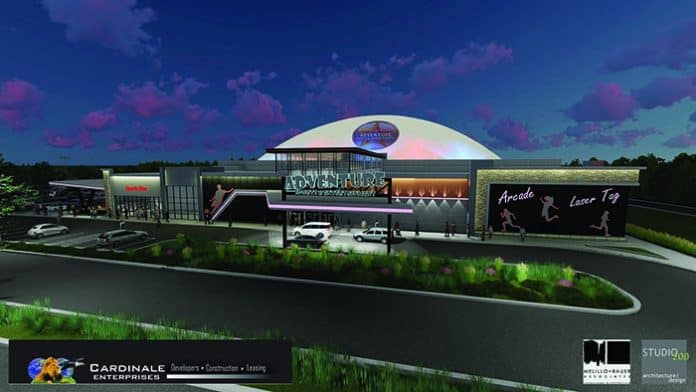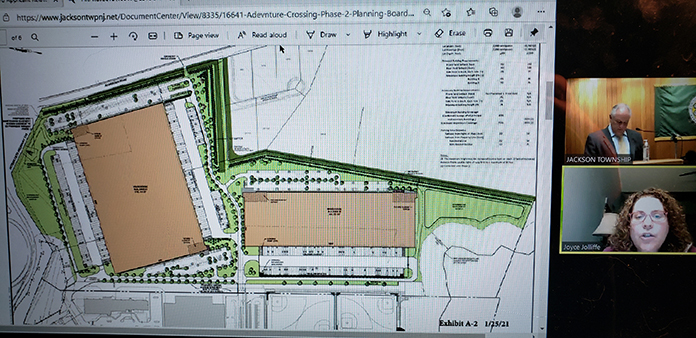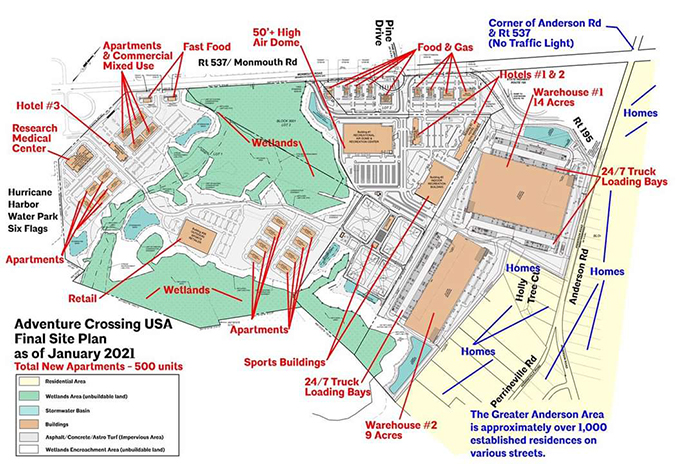
JACKSON – Members of the Township Planning Board unanimously approved an application for the second phase of Adventure Crossing during a recent four-hour meeting.
During a virtual format meeting which also ran close to four hours, there were more than 60 people on the Zoom call. Developer Vito Cardinale of Cardinale Enterprises of Jackson provided details about the second phase of the project.
Adventure Crossing USA (AC) is a 238-acre multi-phase development along Route 537/Monmouth Road that sits between Great Adventure, Six Flags Hurricane Harbor and Anderson Road, Route 195, and the Jackson Outlet Mall.
The project has received some criticism from several environmental groups whose members turned out for the Zoom format meeting. Those groups include Save Barnegat Bay, Residents of Jackson, Clean Water Action, Crosswicks Doctors, Creek Watershed Association Inc. and Environment New Jersey who hoped to convince the Jackson Planning Board to reject the project.
The plan had included the building of two warehouses but revisions to the project now include consolidating the two warehouses into one of 745,000 square feet. Residents and environmental group representatives said the need to remove trees, the amount of diesel exhaust, noise, air and traffic pollution were issues of concern. They expressed concerns about the warehouses operating 24 hours a day, seven days a week on Route 527 and Anderson Road near Route 195 of Garden State Parkway Exit 16.

Township Planner Ernie Peters said the site is located in a mixed-use zone and is proposing a permitted use. “It appears the application is still without variances.”
Revisions to the site plan application of phase II, which received a general development plan approval two years ago, includes the removal 450,000 square foot recreation building which would be substituted for a 340,000 square foot warehouse building.
The plan originally proposed a convention center, a golf area, retail, indoor recreation covering 100,000 square feet, and 250 apartments. While the Zoning Board approved that plan an appeal was made and as a result of a settlement, an amendment was adopted resulting in the warehouse use as an alternate to that project.
Phase III will include a large recreation building near Six Flags Great Adventure, retail, apartments and restaurants as well as a medical office. The center point of the development is a research facility which is now being sought to move ahead to the timeline of phase I.
Three buildings had been approved for warehouses for Phase II but now the two buildings would be consolidated into one creating a 16% decrease in building size, 28% decrease in parking, an increase in the buffer in Holly Tree Court from the required 50 feet to three times the required buffer. A buffer is the amount of space between a development and its neighbors. There would be no access to Anderson Road with the exception of emergency vehicle ingress.
The applicant’s Traffic Consultant John Rea provided testimony during the meeting stating all dedicated access would be through Monmouth Road and no truck access through the first phase I of the project which is adjacent to the site to the west. His position was that the proposal would not contribute any significant additional traffic on Route 537.
Critics Of Development
Critics of the plan such as resident Michael Lasko stated Rea’s report did not take into account the impact additional traffic would have on the Route 195 interchange and adjacent roads, particularly Anderson Road, and Routes 537 and 571.
Deborah Scatuccio of Plymouth Court clarified that New Jersey’s idling law which “clearly states three minutes” not five as previously referenced. She also asked about whether the Township’s Environmental Commission had any objections to the application and if not “why? As there is so much documented information about this very topic available to the public that should have been made available to the Environmental Commission.”
In reference to diesel emissions she added, “I am very concerned about that. Why didn’t the Environmental Commission do any research on this?”
Environmental Commission Chair and Planning Board member Jeff Riker responded, “In regards to the diesel fumes yes there is research. I own several large diesel trucks. In 2005 the emissions law changed. Trucks I own have been grandfathered they have no exhaust fluid injection. They are the dirty diesels. Those have been phased out…The newer trucks that are sold currently you could run them half a million miles and with the new technology and computers they are as clean as a galvanized fence pipe.
“What is happening here is that the older trucks are phased out and once they are out of service they’re done. We have done the research. We can never guarantee that nothing will ever happen but we do look at these kinds of things. We have zero enforcement ability. The enforcement comes from the federal government and the way they are doing that is that they are phasing out the old trucks. Once those grandfathered trucks die so does the truck. As the modern world is progressing, you will see less and less of this,” Riker added.
Janet Tauro who serves as the board chair for Clean Water Action New Jersey asked about the proximity of the four outdoor ball fields as to when the trucks would come in and out “because I am questioning whether this is such a good idea because (due to the fuel emissions) it could be bad for their health breathing in those exhaust fumes.”
She was told that there would be no truck traffic near the ball fields.
Tauro noted that during the prior planning board meeting Cardinale had said he didn’t want to have even one unhappy person. “I think tonight it showed that there is more than one unhappy person. There are groups of unhappy people.” She recommended that the developer preserve the land and get compensated for it.

Save Barnegat Bay Executive Director Britta Forsberg-Wenzel said members of her 50-year-old organization “have spent a lot of time in Jackson recently because you have a lot of land, trees and sit at the head waters of important water bodies. The rivers run down to Barnegat Bay. It is concerning us to see this kind of development on a wooded parcel when we’re going to end up with less trees essentially.”
She added, “this portion of this project which is in the Barnegat Bay watershed is just not ideal for the neighborhood and it is preventing water from making it down to the deeper basins of water to the Barnegat Bay.” She questioned earlier statements made during the night that the site was not in the Barnegat Bay Watershed.
Wenzel was told by staff of the developer that 90 percent of the site was located in the Delaware Watershed and that less than 10 percent of the project was located within the Barnegat Bay Watershed.
This conclusion was drawn by the applicant according to maps from topographical studies which was said to be of higher provision than aerial mapping by published sources. There was no water discharging into the Barnegat Bay Watershed. The applicant maintains no impact is being made to the Barnegat Bay Watershed. Wenzel also echoed Tauro’s idea of Cardinale selling the property to the Ocean County Lands Trust for preservation.
Phase II was approved with the provision that any traffic calming devices that may be required following the site’s development would be addressed by the applicant. A condition was made that Jackson could notify Ocean County regarding warrants for traffic lights. The developer agreed to pedestrian safety devices and a 16-foot height to buffer the perimeter of the plan.
The application was stated to be within the zone’s permitted use and was in line with Jackson’s master plan.







